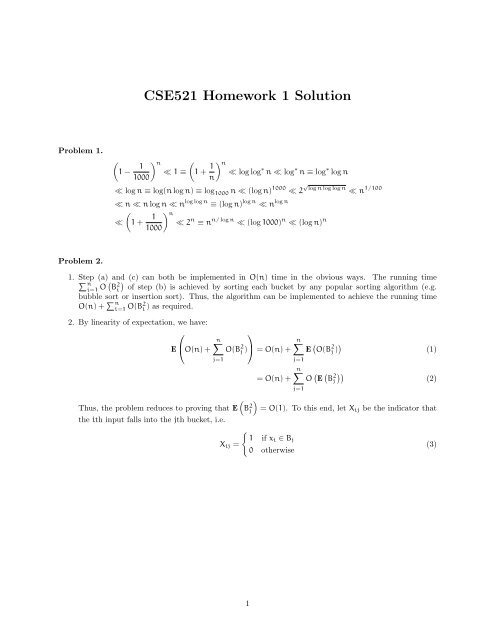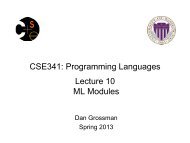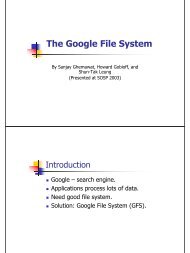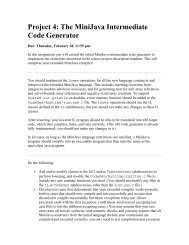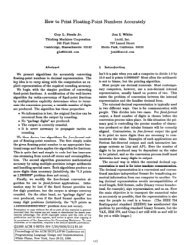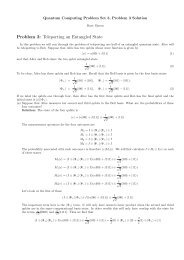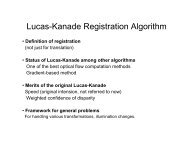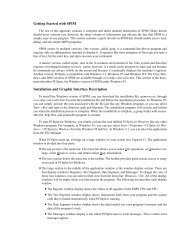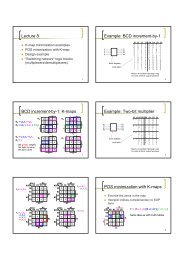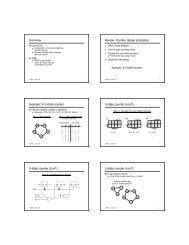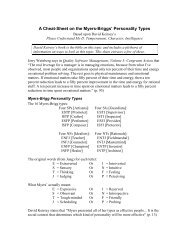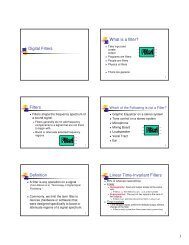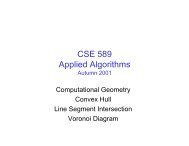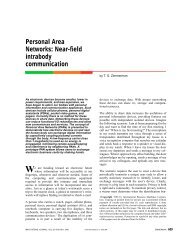CSE521 Homework 1 Solution
CSE521 Homework 1 Solution
CSE521 Homework 1 Solution
Create successful ePaper yourself
Turn your PDF publications into a flip-book with our unique Google optimized e-Paper software.
Problem 1.<br />
Problem 2.<br />
<strong>CSE521</strong> <strong>Homework</strong> 1 <strong>Solution</strong><br />
<br />
1 − 1<br />
n <br />
≪ 1 ≡ 1 +<br />
1000<br />
1<br />
n ≪ log log<br />
n<br />
∗ n ≪ log ∗ n ≡ log ∗ log n<br />
≪ log n ≡ log(n log n) ≡ log 1000 n ≪ (log n) 1000 ≪ 2 √ log n log log n ≪ n 1/100<br />
≪ n ≪ n log n ≪ n log log n ≡ (log n) log n log n<br />
≪ n<br />
≪<br />
<br />
1 + 1<br />
1000<br />
n ≪ 2 n ≡ n n/ log n ≪ (log 1000) n ≪ (log n) n<br />
1.<br />
<br />
Step (a) and (c) can both be implemented in O(n) time in the obvious ways. The running time<br />
n<br />
i=1 O B2 <br />
i of step (b) is achieved by sorting each bucket by any popular sorting algorithm (e.g.<br />
bubble sort or insertion sort). Thus, the algorithm can be implemented to achieve the running time<br />
O(n) + n i=1 O(B2 i ) as required.<br />
2. By linearity of expectation, we have:<br />
⎛<br />
E ⎝O(n) +<br />
n<br />
j=1<br />
O(B 2 j )<br />
⎞<br />
⎠ = O(n) +<br />
= O(n) +<br />
n<br />
E O(B 2 j ) <br />
j=1<br />
n<br />
j=1<br />
O E B 2 <br />
j<br />
<br />
Thus, the problem reduces to proving that E B2 <br />
the ith input falls into the jth bucket, i.e.<br />
j = O(1). To this end, let Xij be the indicator that<br />
<br />
1<br />
Xij =<br />
0<br />
if xi ∈ Bj<br />
otherwise<br />
(3)<br />
1<br />
(1)<br />
(2)
Then, by linearity of expectation:<br />
E B 2 ⎛<br />
<br />
n<br />
j = E ⎝<br />
=<br />
=<br />
=<br />
i=1<br />
Xij<br />
2 ⎞<br />
⎠ (4)<br />
n<br />
E X 2 <br />
ij + 2 E (XijXkj) (5)<br />
i=1<br />
i=k<br />
n<br />
Pr (xi ∈ Bj) + 2 <br />
Pr (xi ∈ Bj and xk ∈ Bj) (6)<br />
i=1<br />
i=k<br />
n<br />
Pr (xi ∈ Bj) + 2 <br />
Pr (xi ∈ Bj)Pr (xk ∈ Bj) (7)<br />
i=1<br />
i=k<br />
= n · 1<br />
1<br />
+ n(n − 1)<br />
n n2 (8)<br />
2. (9)<br />
where (7) follows from the fact that the two events “xi ∈ Bj” and “xk ∈ Bj” are independent; and (8)<br />
follows from the fact that xi and xk are both chosen uniformly at random in [0, 1]. The last inequality<br />
completes the proof.<br />
Problem 3. Given a sequence Z, let Z[i] denote the ith character of Z and Z[: i] denote the subsequence<br />
containing the first ith characters of Z. Given two sequences X and Y, let V[i, j] denote the edit distance of<br />
X[: i] and Y[: j]. Consider the matches of X[i] and Y[j]. There are 3 cases:<br />
1. X[i] is matched with Y[j]. Then V[i, j] can be decomposed into: (i) the cost to match X[i] and Y[j], and<br />
(ii) the cost to match X[: i−1] and Y[: j−1]. Therefore, in this case, V[i, j] = V[i−1, j−1]+c(X[i], Y[j])<br />
where c(α, β) is the cost of replacing α by β, which is 1 if α = β and 0 otherwise.<br />
2. X[i] is matched with Y[k] for k < j. Then V[i, j] can be decomposed into: (i) the cost to insert Y[j] into<br />
X after X[i] or delete Y[j] from Y – these two costs are the same in this question, but in general, we<br />
can take the smaller of the two, and (ii) the cost to match X[: i] and X[: j − 1]. Therefore, in this case,<br />
V[i, j] = V[i, j − 1] + 2.<br />
3. Y[j] is matched with X[k] for k < i. Similar to the above case, we have V[i, j] = V[i − 1, j] + 2.<br />
Since these cases cover all the situations of matching X[: i] and Y[: j], we have the following recurrent<br />
formula<br />
V[i, j] = min (V[i − 1, j − 1] + c(X[i], X[j]), V[i − 1, j] + 2, V[j − 1, i] + 2) (10)<br />
From (10), we can design a dynamic programing algorithm to compute the table V[i, j] for 1 i |X|<br />
and 1 j |Y|. The edit distance between X and Y is V[|X|, |Y|]. The algorithm’s running time is O (|X| · |Y|),<br />
since the computation of each cell of the table using (10) takes O (1) time.<br />
Problem 4.<br />
1. We will prove the correctness of the first algorithm by induction. The correctness of the second<br />
algorithm follows similarly.<br />
• For n = 1 and 2, the algorithm’s correctness can be verified easily.<br />
• Assume that the algorithm works for n/2, we show that it works for n.<br />
Set the coordinate’s origin at the center of the n × n pixel map. Let M and N be the pixel map<br />
before and after the rotation. We need to prove that for all −n/2 < x n/2, −n/2 y n/2,<br />
M[x, y] = N[y, −x]. Assume that x 0 and y 0 (the other cases are symmetric). Let M ′ be<br />
the resulted pixel map after the blit steps. Then M(x, y) = M ′ [x + n/2, y]. By the induction<br />
2
hypothesis, after the rotation step, we have M ′ [x + n/2, y] = N[x ′ , y ′ ], where (x ′ , y ′ ) is the image<br />
of (x + n/2, y) in the −90-degree rotation around (n/4, n/4). Simple algebra shows that x ′ = y<br />
and y ′ = −x, thus completes the proof.<br />
2. Let f(n) be the number of blits the first algorithm performs on a n × n pixel map. Then<br />
f(1) = 0 (11)<br />
f(n) = 4f(n/2) + 5 for n > 1 (12)<br />
This recurrent formula yields f(n) = 5(n 2 − 1)/3.<br />
The number of blits the second algorithm performs follows exactly the same recurrent formula. Thus<br />
the second algorithm performs the same number of blits with the first one.<br />
3. Let T(n) be the running time of the first algorithm on a n × n pixel map. We have:<br />
T(1) = 0 (13)<br />
2 n<br />
T(n) = 4T(n/2) + 5O<br />
for n > 1 (14)<br />
4<br />
By Master Theorem, we have T(n) = O n 2 log n .<br />
The running time of the second algorithm can be analyzed similarly.<br />
4. Similar to above, the running time T(n) of the first algorithm on a n × n pixel map satisfies the<br />
following recurrent formula:<br />
T(1) = 0 (15)<br />
<br />
n<br />
<br />
T(n) = 4T(n/2) + 5O<br />
for n > 1 (16)<br />
2<br />
Again, by Master Theorem, we have T(n) = O n 2 .<br />
The running time of the second algorithm can be analyzed similarly.<br />
Problem 5. The problem can be solved by a breath-first traversal of (each connected component of)<br />
the graph. Every time we visit a node, we mark it as visited. If we ever re-visit a visited node, the graph<br />
contains a cycle. Otherwise, it’s a forest. This ways, each node is visited at most once (except for possibly<br />
one node in case the graph does contain a cycle) and each edge is visited at most twice. Thus, the running<br />
time is O (n + m).<br />
3


